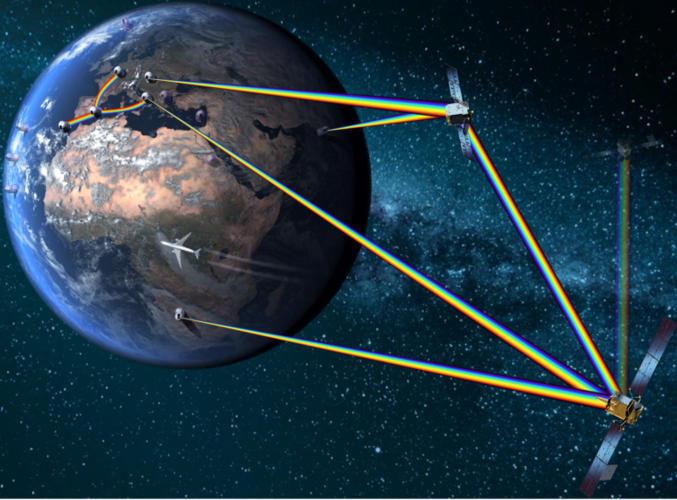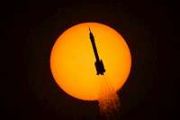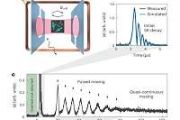
Copernical Team
Super-precise satellite time synchronization achieves picosecond accuracy
 A cutting-edge carrier-phase-based approach to satellite-ground time synchronization has reached an unprecedented level of precision, achieving picosecond-level accuracy. This breakthrough stands to redefine global navigation, deep space exploration, and high-precision scientific research by effectively mitigating errors such as motion delays, relativistic distortions, and atmospheric disturbanc
A cutting-edge carrier-phase-based approach to satellite-ground time synchronization has reached an unprecedented level of precision, achieving picosecond-level accuracy. This breakthrough stands to redefine global navigation, deep space exploration, and high-precision scientific research by effectively mitigating errors such as motion delays, relativistic distortions, and atmospheric disturbanc First astronaut with a disability cleared for space station mission
 The first-ever astronaut with a physical disability has been cleared for a mission onboard the International Space Station, the European Space Agency announced on Friday.
John McFall, a 43-year-old British surgeon and former Paralympian who lost a leg in a motorbike accident when he was 19, said he was "hugely proud" of clearing the hurdle.
Since announcing McFall as a member of its astr
The first-ever astronaut with a physical disability has been cleared for a mission onboard the International Space Station, the European Space Agency announced on Friday.
John McFall, a 43-year-old British surgeon and former Paralympian who lost a leg in a motorbike accident when he was 19, said he was "hugely proud" of clearing the hurdle.
Since announcing McFall as a member of its astr SpaceX's workhorse Falcon 9 booster launches 21 Starlink satellites from Florida
 SpaceX early Saturday launched another 21 Starlink satellites aboard a record-setting Falcon 9 first-stage booster from Canaveral Space Force Station in Florida.
Liftoff was at 1:14 a.m. from pad 40 with clouds obscuring the rocket.
It was the 27th time this first-stage booster was used. It landed eight later at SpaceX droneship A Shortfall of Gravitas. This was the 98th booster
SpaceX early Saturday launched another 21 Starlink satellites aboard a record-setting Falcon 9 first-stage booster from Canaveral Space Force Station in Florida.
Liftoff was at 1:14 a.m. from pad 40 with clouds obscuring the rocket.
It was the 27th time this first-stage booster was used. It landed eight later at SpaceX droneship A Shortfall of Gravitas. This was the 98th booster NASA: 1.6% chance newly discovered asteroid will impact Earth in 2032
 NASA's Jet Propulsion Laboratory has declared a 1.6% chance that a large asteroid would strike the Earth on Dec. 22, 2032.
Scientists at NASA and the European Space Agency are among those closely watching the asteroid that measures between 130 and 300 feet in diameter and whose trajectory gives it a slight chance of impacting Earth in late 2032, the ESA reported Monday.
"An aster
NASA's Jet Propulsion Laboratory has declared a 1.6% chance that a large asteroid would strike the Earth on Dec. 22, 2032.
Scientists at NASA and the European Space Agency are among those closely watching the asteroid that measures between 130 and 300 feet in diameter and whose trajectory gives it a slight chance of impacting Earth in late 2032, the ESA reported Monday.
"An aster ESA's HydRON project for space-based optical communications moves forward

The European Space Agency (ESA) has jointly signed a contract with Thales Alenia Space to develop Element #2 of its High-throughput Digital and Optical Network (HydRON), an advanced laser-based satellite system that will transform the way we communicate in space. This phase will establish a satellite collector in low Earth orbit (LEO), capable of connecting different orbital layers using cutting-edge optical technology.
Sentinel-1C demonstrates power to map land deformation

Launched just two months ago and still in the process of being commissioned for service, the Copernicus Sentinel-1C satellite is, remarkably, already showing how its radar data can be used to map the shape of Earth’s land surface with extreme precision.
These first cross-satellite ‘interferometry’ results assure its ability to monitor subsidence, uplift, glacier flow, and disasters such as landslides and earthquakes.
Pierogi in space

In a first for space cuisine, ESA project astronaut Sławosz Uznański-Wiśniewski will bring pierogi, the traditional Polish dumplings, to the International Space Station during the upcoming Axiom Mission 4.
Earth from Space: Heart of Mount St Helens
 Image:
For Valentine’s Day, the Copernicus Sentinel-2 mission picks out a heart in the landscape north of Mount St Helens in the US state of Washington.
Image:
For Valentine’s Day, the Copernicus Sentinel-2 mission picks out a heart in the landscape north of Mount St Helens in the US state of Washington. Fly! Project media briefing
 Video:
00:42:11
Video:
00:42:11
Watch the latest updates on ESA’s Fly! Feasibility Study with Daniel Neuenschwander, ESA Director of Human and Robotic Exploration, John McFall, Member of the ESA Astronaut Reserve & Fly! Subject Matter Expert, Jerome Reineix, Fly! Study Manager, and Alessandro Alcibiade, Fly! Flight Surgeon.
Announced in November 2022 during the Ministerial Council held in Paris, France, this unique and groundbreaking study is aimed at understanding and challenging the limitations posed by physical disabilities to human spaceflight. Concluded in late 2024, the Fly! Feasibility Study successfully demonstrated it is technically feasible to fly someone with a physical disability, like John’s,
Week in images: 10-14 February 2025

Week in images: 10-14 February 2025
Discover our week through the lens































